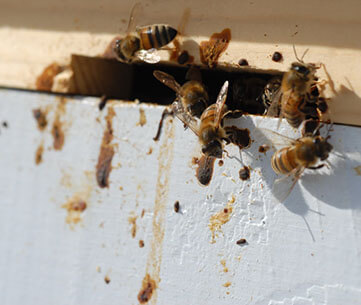 by Juan Molina
by Juan Molina As the saying goes, “a practical example is worth a thousand words.” With this in mind, we have begun collaborating with veterinarians to share clinical cases they’ve encountered during visits to apiaries. As you’ll see, the underlying cause can often be quite different from what you might initially suspect. In our inaugural clinical case, Dr. Juan Molina will share an instance from Spain involving significant hive losses.
In November, we received a call at our office from a beekeeper, who, according to the hive census, is considered a professional. He reported observing serious health issues among his hives. When asked about varroa mite infestation, he indicated that the level was at an average of 8-10%. He also observed bees with damaged wings. Despite the hives being treated for varroosis, the apiary experienced significant losses. From the 60 hives present at the season’s start, only 20 remained. The populations dwindled until they vanished entirely. Following this, we arranged an inspection and sampling visit.
Location & weather: The apiary is nestled within a pine forest and scrubland, situated near the Mediterranean coast in the province of Malaga. It’s accessible by roads, with the Mediterranean highway not far off, marking it as a relatively confined natural space. The climate here is exceptionally mild, characterized by warm temperatures year-round. The summers are temperately warm, thanks to the sea’s proximity, which allows for continuous hive activity throughout the year.
Nutritional & Sanitary management: The beekeeper utilizes Layens hives with 12 frames, though he operates with 11 frames, without a crown board and with the head slat split for feeding purpose. During times of scarcity, the beekeeper supplements the bees’ diet with sucrose patties that contain a small amount of vitamins but no protein.
Sanitary practices are primarily confined to the use of acaricide strips. The beekeeper has employed strips based on amitraz, approved for bees, as well as cattle treatments also based on amitraz, following another beekeeper’s advice. [Disclaimer: This practice is illegal and should not be replicated]. Additionally, there has been an increase in moth (G. mellonella) issues more than ever before.
The beekeeper notes that many of the queens are about a year old, as he has been creating “blind nuclei” in the prior season.
The hives have not been relocated and have stayed in the same apiary throughout the year.
Nearby, there are other apiaries, and since the closest one was established, the beekeeper has noticed a decline in his hives’ condition. He is unfamiliar with this neighboring beekeeper and suspects that they are not professional.
The apiary’s overall appearance is notably unkempt, with various materials used as covers or hive stands. Many hives exhibit cracks and poor assembly, with numerous covers showing signs of deformation or metal cracking. The beekeeper does not clean or sanitize materials in storage, nor does he disinfect empty hives or frames. However, he does apply an alcohol solution to his gloves before beginning apiary visits.
Upon inspecting the hives, there was no evidence of mortality either at the hive entrances or at the bottoms of the open hives. There was an absence of noticeable activity at the front, necessitating the opening of the hives to verify the colonies’ survival. Inside, dead bees were discovered emerging from the cells with their proboscises and glossae extended. Additionally, a spotty brood pattern and severe depopulation were observed in these same hives. Although the queen was found, there was no evidence of recent egg-laying.
The hive bottoms contained the usual debris, including pollen remnants and opercula, without signs of moth infestation at the time of the visit.
In one of the hives, up to four acaricide strips from two different manufacturers were found. Upon opening a capped cell and extracting the larva, varroa mites were observed at the base. Additionally, these mites were detected in a phoretic state on the brood box, persisting even with acaricide strips in place. When inquired about the duration of the acaricidal treatment, the beekeeper admitted the strips had been left in place for over five months.
In the empty cells of the breeding boxes, neither scales nor mummified larvae were present, nor was there any putrid odor detected.
There was no occurrence of robbing in the collapsed hives, and generally, the apiary exhibited little activity since most of the hives were empty, and those still alive had significantly low populations. The hives had scant honey reserves and almost no pollen, with the beekeeper not having harvested from the apiary either.
It wasn’t the season for predation by bee-eaters (Merops apiaster) or the oriental hornet (Vespa orientalis), which has recently been found in southern Spain. The beekeeper reported no significant predation in this apiary. A check of the wasp sighting map confirmed no nearby nests had been recorded.
Two samples were collected from two depopulated hives and were sent, refrigerated, on the same day to the Laboratory of the Marchamalo Beekeeping and Agro-Environmental Research Center (CIAPA) for examination, with a request for Nosema analysis. Due to financial constraints, testing for paralysis viruses (ABPV, CBPV) and Deformed Wing Viruses (DWV) was not conducted. Owing to the challenge of collecting forager bees, the samples were taken from nurse bees instead. The analysis revealed a high parasite burden of Nosema ceranae, and the presence of phoretic Varroa mites was also confirmed.

The beekeeper is advised to enhance the overall hygiene of the farm by implementing several measures:
A telephone check-in was conducted a few weeks following the initial advice. The beekeeper had administered a stimulant feed and introduced oregano essential oil into the regimen, a tip he received from a fellow beekeeper [Disclaimer: Exercise caution with the use of essential oils, as they can be highly toxic to honey bees].
Three months later, the apiary underwent another evaluation due to the beekeeper’s continued losses, with only about half a dozen hives remaining alive. The inspection once again revealed completely depopulated hives, with no signs of mortality at the entrances or hive bottoms. The bees that were still alive appeared very weak, exhibited short abdomens due to starvation, and there were instances of bees dying as they attempted to emerge from their cells.
We are witnessing an escalating challenge in maintaining healthy and productive hives. The persistent issue of varroa mites1, compounded by an increasing emergence of resistance to commonly used acaricides among beekeepers, often results from misinformation or incorrect application of treatments.
Additionally, the parasitization by the Nosema ceranae microsporidium2, prevalent in most Iberian Peninsula apiaries, exacerbates the issues caused by varroa mites and other pathogens, leading to severe depopulation. This depopulation in turn affects the efficacy of long-lasting acaricides, enhancing the mites’ detrimental impact.
Varroa not only acts as a parasite but also as a vector for viral diseases.2,3 While we couldn’t assess the viral load in this case, it is known to fluctuate throughout the year and significantly impacts the overall health of the hive.4
The visits to the case occurred in the last months of 2023 and early 2024. According to climate records, 2023 was the warmest year on record5, with southern Spain experiencing over four years of severe drought.6 The onset of heatwaves in May significantly impacted the spring bloom, leading to dry nectaries and pollen grains lacking in sugars, fats, and proteins. This nutritional deficit significantly influences the hive’s condition, which, far from being productive, becomes heavily reliant on supplemental feeding at certain times of the year.
In summary, numerous losses of hives are recorded due to multiple factors that add up, subjecting bee colonies to stress due to parasitic diseases (varroa, nosema) and increasing viral loads that they must face in a state of prolonged malnutrition.7 Beekeeping is forced to move from an extensive model to one that is highly dependent on supplies, not because of the intensification of management but because of increasingly adverse environmental conditions.
About the Author
Juan Molina is a veterinarian from the Universidad de Córdoba with specialization in beekeeping from the Universidad Complutense. Deeply passionate about apiculture, he’s affiliated with the Asociación Malagueña de Apicultores and has authored two books on the subject. Juan’s roles have ranged from Quality Manager for honey to imparting courses for bee enthusiasts.
References:
1. Rosenkranz P., Aumeier P.& Ziegelmann B. (2012). – Biology and control of Varroa destructor. J Invertebr. Pathol., 103 (1) 96-119 https://www.sciencedirect.com/science/article/abs/pii/S0022201109001906?via%3Dihub
2. Botías, C., Martín-Hernández, R., Barrios, L. (2011).- Nosema spp. parasitization decreases the effectiveness of acaricide strips (Apivar®) in treating varroosis of honey bee (Apis mellifera iberiensis) colonies
3. Sammataro D. (1997) Report on parasitic honey bee mites and disease associations. Bee J., 137, 301-302
4. Šimenc , Knific T., Toplak I., 2021, The Comparison of Honeybee Viral Loads for Six Honeybee Viruses (ABPV, BQCV, CBPV, DWV, LSV3 and SBV) in Healthy and Clinically Affected Honeybees with TaqMan Quantitative Real-Time RT-PCR Assays
5. https://edo.jrc.ec.europa.eu/documents/news/GDO-EDODroughtNews202305_Western_Mediterranean.pdf
6. https://wmo.int/media/news/wmo-confirms-2023-smashes-global-temperature-record
7. Higes M., Martín-Hernández R., (2008) How natural infection by Nosema ceranae causes honeybee colony collapse. Microbiol. Rep., 1, 110-113
 by Juan Molina
by Juan Molina Table of contents Winter is when most of the honeybee colony losses occur. Bees enter a phase where they must rely on their stored food reserves. Weeks before, still in
 by Ulrike Marsky
by Ulrike Marsky Join the Véto-pharma community and receive our quarterly newsletter as well as our occasional beekeeping news. You can unsubscribe at any time if our content does not suit you, and your data will never be transferred to a third party!

© 2019-2024, Véto-pharma. All rights reserved